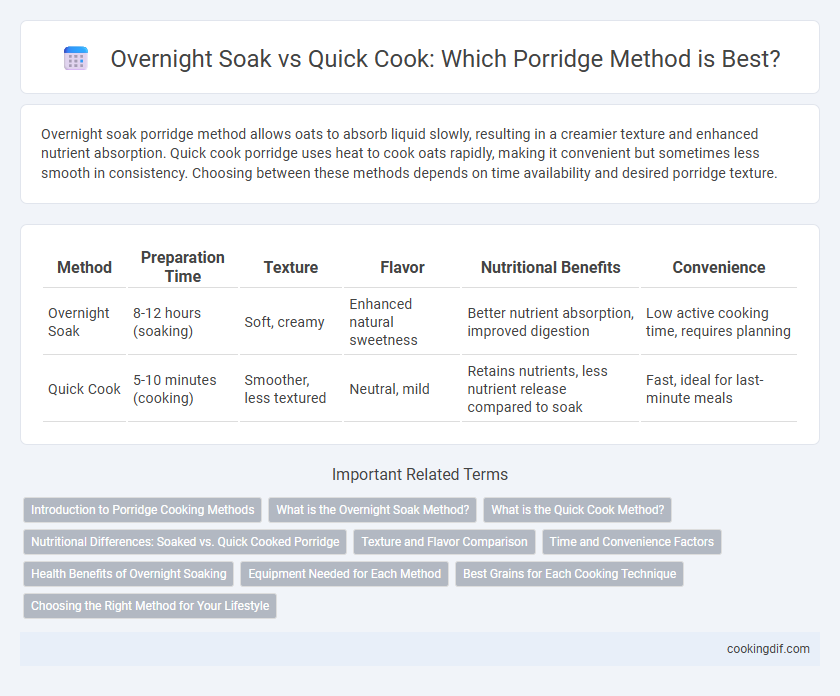Overnight soak porridge method allows oats to absorb liquid slowly, resulting in a creamier texture and enhanced nutrient absorption. Quick cook porridge uses heat to cook oats rapidly, making it convenient but sometimes less smooth in consistency. Choosing between these methods depends on time availability and desired porridge texture.
Table of Comparison
| Method | Preparation Time | Texture | Flavor | Nutritional Benefits | Convenience |
|---|---|---|---|---|---|
| Overnight Soak | 8-12 hours (soaking) | Soft, creamy | Enhanced natural sweetness | Better nutrient absorption, improved digestion | Low active cooking time, requires planning |
| Quick Cook | 5-10 minutes (cooking) | Smoother, less textured | Neutral, mild | Retains nutrients, less nutrient release compared to soak | Fast, ideal for last-minute meals |
Introduction to Porridge Cooking Methods
Overnight soak porridge involves soaking grains like oats or rice in liquid for several hours or overnight, enhancing digestibility and reducing cooking time by softening the grains beforehand. Quick cook porridge uses pre-processed oats or grains that have been rolled thin or chopped finely, allowing for rapid cooking within minutes, ideal for busy mornings. Both methods cater to different preferences, with overnight soak emphasizing natural texture and nutrition, while quick cook focuses on convenience and speed.
What is the Overnight Soak Method?
The Overnight Soak Method for porridge involves soaking oats in liquid, such as milk or water, for several hours or overnight, allowing the grains to absorb moisture and soften naturally. This process enhances digestibility and results in a creamy texture without the need for prolonged cooking. Nutrient retention is higher compared to quick cook methods, preserving vitamins and minerals for a healthier breakfast option.
What is the Quick Cook Method?
The Quick Cook method for porridge involves cooking oats rapidly, usually within 1 to 5 minutes, by boiling them in water or milk on a stovetop or microwave. This technique uses pre-steamed or finely cut oats, enabling fast water absorption and softening without the lengthy soaking process. Quick Cook porridge offers convenience and speed while maintaining a creamy texture and essential nutrients.
Nutritional Differences: Soaked vs. Quick Cooked Porridge
Overnight soaked porridge retains more nutrients by allowing grains to release enzymes, reducing phytic acid and enhancing mineral absorption compared to quick-cooked porridge. Quick cook porridge often loses some water-soluble vitamins and minerals due to high heat and shorter cooking time. Soaked oats provide better digestion and sustained energy release, making them nutritionally superior to instant or fast-cooking oats.
Texture and Flavor Comparison
Overnight soaking porridge results in a creamier, more velvety texture as grains fully absorb liquid, enhancing natural sweetness and depth of flavor through slow fermentation. Quick cooking retains a firmer, chewier bite with a more straightforward, mild grain taste but sacrifices some of the complex, rich nuances developed during extended soaking. Choosing between methods depends on desired porridge consistency and flavor intensity, with overnight soak favored for smoothness and quick cook suited for convenience and a rustic texture.
Time and Convenience Factors
Overnight soak porridge requires minimal morning preparation as oats absorb water or milk over several hours, resulting in a creamy texture without active cooking time. Quick cook porridge methods reduce total cooking to just a few minutes on the stove or microwave, offering a faster option for busy mornings. Choosing between overnight soak and quick cook depends on balancing convenience with texture preference and available prep time.
Health Benefits of Overnight Soaking
Overnight soaking porridge grains enhances nutrient absorption by breaking down phytic acid, which inhibits minerals like iron, calcium, and zinc. This method also improves digestion and reduces cooking time, preserving heat-sensitive vitamins such as B-complex. Compared to quick cook options, overnight soaked porridge supports better gut health and sustained energy release through increased bioavailability of essential nutrients.
Equipment Needed for Each Method
Overnight soak porridge requires minimal equipment, typically just a container or bowl with a lid for soaking the oats and a refrigerator to keep them chilled. Quick cook porridge demands a heat source such as a stove or microwave and a pot or microwave-safe bowl to rapidly cook the oats. Both methods benefit from a sturdy spoon or spatula for stirring, but quick cook techniques often require more precise temperature control equipment.
Best Grains for Each Cooking Technique
Steel-cut oats are ideal for overnight soaking due to their dense texture and ability to absorb liquid evenly, resulting in creamy porridge with minimal cooking time the next day. Quick-cooking oats, such as rolled oats or instant oats, are best suited for rapid preparation methods since they are processed to cook swiftly without sacrificing texture. Choosing whole grains like barley or quinoa works well for slow soaking methods, while pre-steamed grains align better with quick-cook porridge recipes for balanced flavor and consistency.
Choosing the Right Method for Your Lifestyle
Overnight soak porridge enhances nutrient absorption and reduces cooking time, making it ideal for busy mornings or meal prepping. Quick cook methods offer convenience and speed, perfect for those with limited time or spontaneous breakfast needs. Selecting the right approach depends on your daily schedule and preference for texture and flavor intensity.
Overnight soak vs Quick cook for porridge method Infographic

 cookingdif.com
cookingdif.com